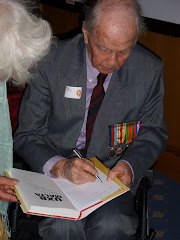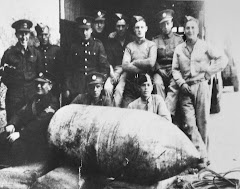Former bomb disposal officers whose service spans seven decades stood to attention as a roll of honour carrying the names of more than 500 men killed carrying out this dangerous task was played out before them. The act of remembrance was part of a moving presentation commemorating the 70th anniversary of Royal Engineers Bomb Disposal at the RE Museum in Gillingham. The event included the official UK launch of UXB Malta, the history of RE Bomb Disposal on the Island from 1940 to 1944.
The event brought together former wartime Bomb Disposal Officer Lt George Carroll with Major (Retd) Simon Cooke, RE, who recently served in Explosive Ordnance Disposal (EOD) in Bosnia and Afghanistan. Major Cooke compared the challenges of present day EOD operations with the first years of the service during World War 2:
“I think that the principle difference is a shift in focus from dealing with factory made, mass-produced munitions and bombs that have failed to go off [in 1940], to improvised terrorist devices today.” Major Cooke also described the way in which modern technology is used to reduce risk by taking the bomb disposal officer out of direct contact with the bomb, such as sophisticated robots which can attack the bombs themselves but also monitor and sometimes jam signals which could trigger the bomb.
However, he was also keen to point out the similarities between the work of the World War 2 bomb disposal officer and his modern day counterpart, whether in Iraq or Afghanistan – or in the UK. “Who would have thought that the bombs dropped in the Blitz in London would still crop up today? But they do.” And RE bomb disposal officers still deal with them in very the same way, employing the same techniques and equipment that they did in World War 2.
But Simon Cooke had other reasons to feel a close affinity with 92 year old George Carroll: “Some things in bomb disposal never change; the capacity to think through a technical problem very quickly; to improvise in the most demanding, high pressure and stressful of circumstances; and to follow through and execute your plan to dispose of a high explosive bomb (of whatever description); something that, if you get it wrong, you know will kill you. This places massive responsibility on young shoulders; it did in World War 2. It does now.
… the very nature of bomb disposal is, for safety reasons, a one-man-risk. At the cutting edge, bomb disposal is not a team activity, it is an individual activity. You live or die on your own wits, skill and judgement. And that takes courage.”
It seems the unifying similarity between bomb disposal officers throughout the past 70 years is the selfless and cool courage of young men who, despite all their achievements, remain typically modest and self-effacing.
SIMON COOKE is now Managing Director of 6 Alpha Associates, a niche security and risk management consultancy providing services in EOD, counter-terrorism and business resilience. www.6alpha.com
Wednesday, 26 May 2010
Presidential Book Launch in Malta
Former President of Malta Edward Fenech Adami was guest of honour at the launch of UXB Malta, hosted by Fondazzjoni Wirt Artna at the Saluting Battery in Valletta. He was presented with a copy of the book which tells how as an eight year old in 1942 his life was saved from an unexploded butterfly bomb by the RE Bomb Disposal Officer. Also attending were others who contributed personal stories to UXB Malta, as well as representatives of Malta’s military heritage organisations and George Cross Island Association.
Friday, 7 May 2010
70th Anniversary of RE Bomb Disposal Commemoration 11 May 2010
“I was always aware that I might be killed, but you had a job to do. You couldn’t allow yourself to be overcome by your feelings.” So says former Lt George Carroll, one of the oldest surviving bomb disposal officers of the London blitz, on Channel 4 documentary ‘Blitz Street’.
92 year old George Carroll will be guest of honour at a gathering to mark the 70th anniversary of Army bomb disposal on Tuesday 11 May, at the Royal Engineers (RE) Museum in Gillingham, Kent. He will be formally presented with a copy of ‘UXB Malta’ in memory of his service as one of the handful of men who dealt with 7300 unexploded bombs in just two years of World War 2, often under enemy fire.
George Carroll will meet and compare his wartime experiences with former officers whose careers span seven decades of bomb disposal. Joining them will be the families of those who served in the blitz on Malta.
At noon they will unite in remembering the many who have lost their lives in this hazardous occupation, and acknowledge the courage of those still dealing with disabilities resulting from their service. Losses were heaviest in the first five years. In 1940 the average life expectancy of bomb disposal officers was ten weeks. By the end of the war 490 officers and men had been killed and 209 injured.
The challenge they face has changed little since then: an enemy constantly developing new bombs designed to kill them. George Carroll still vividly remembers dealing with his first unexploded bomb, three weeks before he had any training. As the Germans introduced ever more complex fuzes, he learned as he went along – and survived – even when a Messerschmitt pilot strafed the ground with bullets while he was working on a 1000kg Hermann bomb.
Today’s bomb disposal personnel undergo extensive training and preparation before being deployed on active service. But in Iraq and Afghanistan they have to deal with the deadly unpredictability of Improvised Explosive Devices (IED, each one individually made in an attempt to outwit them.
Yet despite the years which divide them, it seems that bomb disposal men have at least one thing in common. When described as heroes, they all give a similar response: they were ‘just doing a job’.
92 year old George Carroll will be guest of honour at a gathering to mark the 70th anniversary of Army bomb disposal on Tuesday 11 May, at the Royal Engineers (RE) Museum in Gillingham, Kent. He will be formally presented with a copy of ‘UXB Malta’ in memory of his service as one of the handful of men who dealt with 7300 unexploded bombs in just two years of World War 2, often under enemy fire.
George Carroll will meet and compare his wartime experiences with former officers whose careers span seven decades of bomb disposal. Joining them will be the families of those who served in the blitz on Malta.
At noon they will unite in remembering the many who have lost their lives in this hazardous occupation, and acknowledge the courage of those still dealing with disabilities resulting from their service. Losses were heaviest in the first five years. In 1940 the average life expectancy of bomb disposal officers was ten weeks. By the end of the war 490 officers and men had been killed and 209 injured.
The challenge they face has changed little since then: an enemy constantly developing new bombs designed to kill them. George Carroll still vividly remembers dealing with his first unexploded bomb, three weeks before he had any training. As the Germans introduced ever more complex fuzes, he learned as he went along – and survived – even when a Messerschmitt pilot strafed the ground with bullets while he was working on a 1000kg Hermann bomb.
Today’s bomb disposal personnel undergo extensive training and preparation before being deployed on active service. But in Iraq and Afghanistan they have to deal with the deadly unpredictability of Improvised Explosive Devices (IED, each one individually made in an attempt to outwit them.
Yet despite the years which divide them, it seems that bomb disposal men have at least one thing in common. When described as heroes, they all give a similar response: they were ‘just doing a job’.
Subscribe to:
Comments (Atom)





